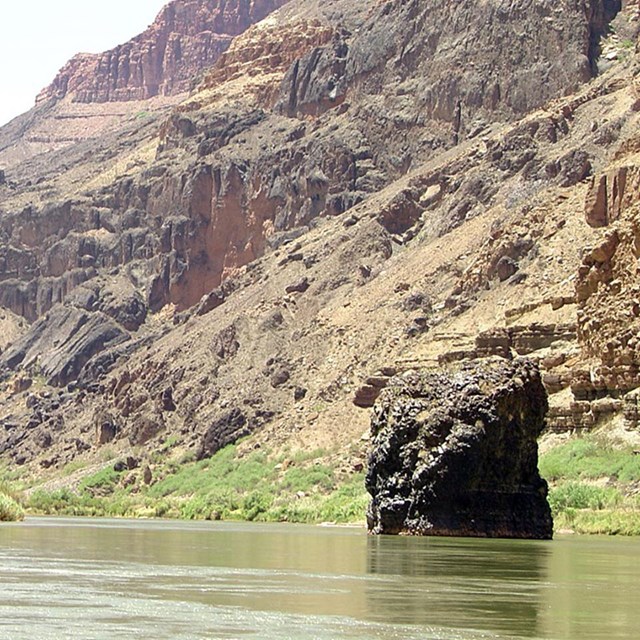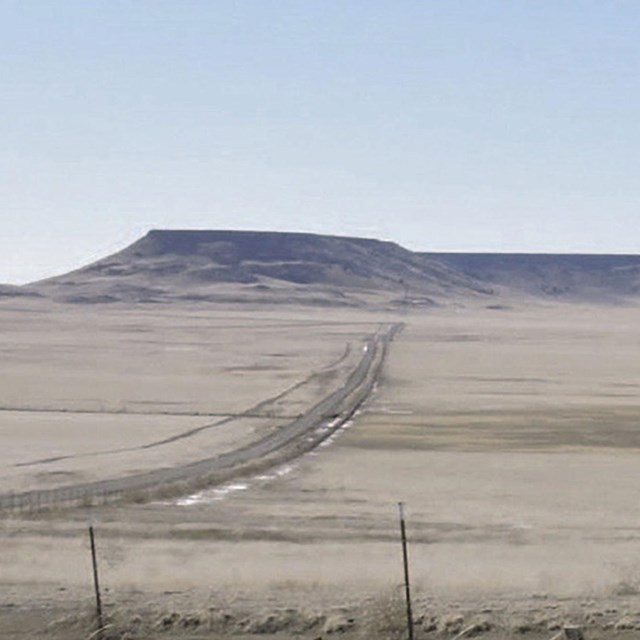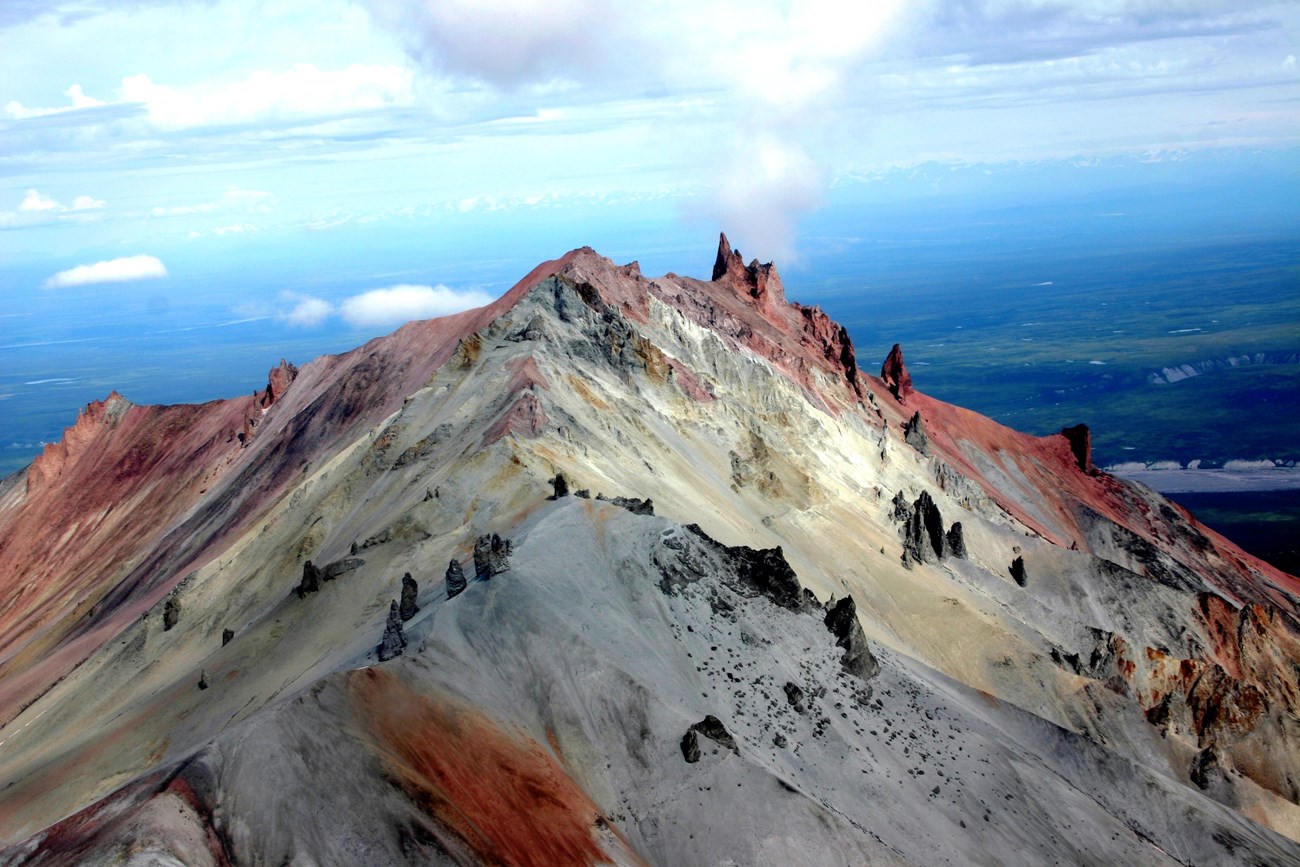
NPS photo.
Introduction
Most volcanoes are constructional in that they build landforms. Their eruptions may construct massive mountains that reach into the sky, build new land on volcanic islands and on the coasts of continents, and/or vast areas with lava flows.
But like any geologic landform, volcanoes and volcanic deposits are subject to the ravages of weathering and erosion. Through time, volcanic edifices may be eroded so that they retain just a relic of their former mass. Volcanic islands can even be completely lost to the sea.
Older volcanoes are generally more eroded than younger ones. The amount of erosion on volcanic edifices in a volcanic field is a good indicator of their relative ages.


Left image
Capulin Volcano and Horseshoe Crater are both cinder cones in the Raton-Clayton Volcanic Field and are approximately 7.5 miles (12 km) apart. Horseshoe Crater is much older than Capulin Volcano, having erupted approximately 440,000 years ago.
Right image
Horseshoe Crater has experienced much more erosion than the younger Capulin cinder cone. As a result, Horseshoe Crater has assumed a rounded shape, has lost its classic cinder cone profile, and lost a considerable portion of its original height.

NPS photo by Chris Roundtree.
Eroded Volcanic Landforms
Volcanic necks and inverted topography are two iconic types of eroded volcanic landforms.
-
Volcanic necks are the remnants of a volcano’s conduit and plumbing system that remain after most of the rest of the volcano has been eroded away.
- Inverted topography arises when lava flows that filled valleys at the time of their eruption later hold up mesas because their resistance to erosion is greater than most other rock types.
Learn More
National Park Sites with Erosional Volcanic Landforms
Many units of the National Park System contain eroded volcanic landforms since volcanoes and volcanic deposits begin to erode as soon as they form. Poorly consolidated volcanic deposits erode away more quickly than hard lava flows, and erosion rates differ in areas with wetter climates where there is more rapid weathering and erosion than in places that are more arid. Through time, volcanic landforms and deposits may lose identifiable features such as vents or craters formed during volcanic activity, and the presence of igneous rocks may be the only remaining evidence of past volcanic activity.
Three parks were set aside primarily for their erosional volcanic landforms.
Chiricahua National Monument, Arizona
Chiricahua National Monument’s rock hoodoos and spires are erosional landforms. They result from erosion along systems of intersecting joints in the Rhyolite Canyon Tuff. This welded tuff (ignimbrite) was erupted about 26.5 million years ago from the Turkey Creek Caldera located south of the park. In addition to its charismatic pinnacles, spires, and balanced rocks, the park also contains slot canyons, a natural bridge, and tafoni (cavernous openings or pits in rock surfaces) eroded in this tuff.
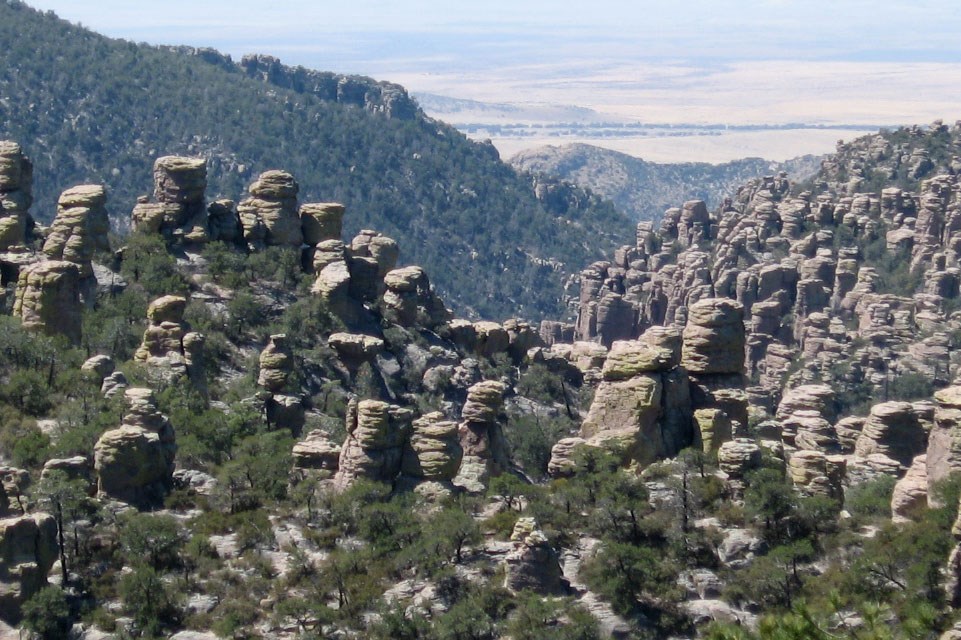
NPS photo.
Devils Tower National Park, Wyoming
Devils Tower is a nearly vertical monolith and is one of the most striking landforms in the United States. The tower reaches to 5,112 feet (1,559 m) in elevation and is 867 feet (265 m) tall. It is made of igneous rock that was either a part of a volcanic neck or a shallow intrusion. Well-developed columnar jointing that formed during cooling and contraction of the igneous body is among its most dramatic features. The rocks that make up Devils Tower crystallized about 50 million years ago, but the tower itself is an erosional landform that mostly likely formed in the last 5-10 million years.
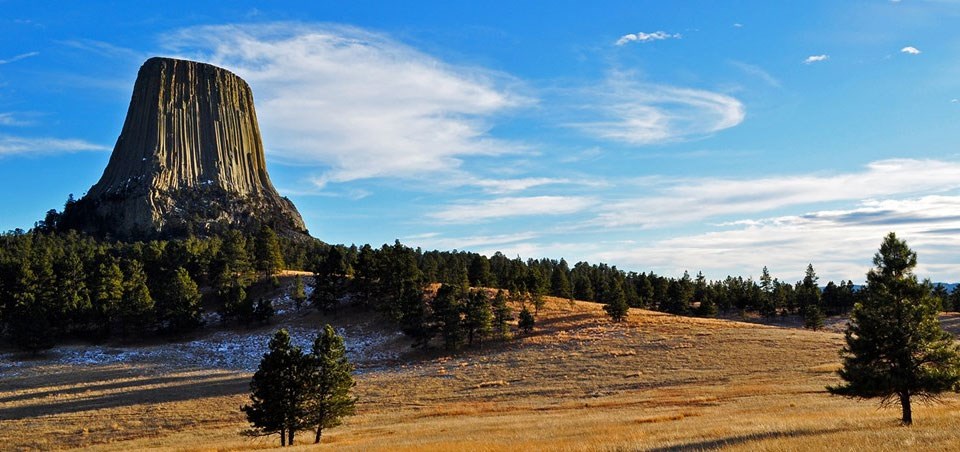
NPS photo by S. Carter.
Pinnacles National Park, California
Pinnacles National Park is famous for its namesake pinnacles which are the result of erosion along joint systems. The park contains the deeply-eroded remnants of a volcanic center or field that was active about 23 million years ago, but vents and volcanic landforms are no longer present in the park. The Pinnacles-Neenach Volcanic Field consisted of volcanic domes, small composite volcanoes, and other vents. Rocks in the park include rhyolite breccia, flow-banded rhyolite, dacite, andesite, and welded tuff. The Pinnacles-Neenach Volcanic Field is most notable for being cut by the San Andreas Fault which moved the Pinnacles portion about 200 miles (320 km) north of the Neenach volcanics.

NPS Photo.

NPS photo.
Featured Parks
-
Capitol Reef National Park (CARE), Utah—[CARE Geodiversity Atlas] [CARE Park Home] [CARE npshistory.com]
-
Capulin Volcano National Monument (CAVO), New Mexico—[CAVO Geodiversity Atlas] [CAVO Park Home ] [CAVO npshistory.com]
-
Chiricahua National Monument (CHIR), Arizona—[CHIR Geodiversity Atlas] [CHIR Park Home] [CHIR npshistory.com]
-
Devils Tower National Monument (DETO), Wyoming—[DETO Geodiversity Atlas] [DETO Park Home] [DETO npshistory.com]
-
Grand Canyon National Park (GRCA), Arizona—[GRCA Geodiversity Atlas] [GRCA Park Home] [GRCA npshistory.com]
-
Pinnacles National Monument (PINN), California—[PINN Geodiversity Atlas] [PINN Park Home] [PINN npshistory.com]
-
Wrangell-St. Elias National Park and Preserve (WRST), Alaska—[WRST Geodiversity Atlas] [WRST Park Home] [WRST npshistory.com]
Last updated: April 17, 2023

